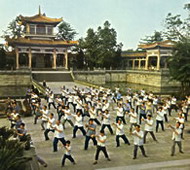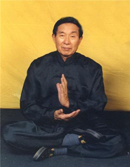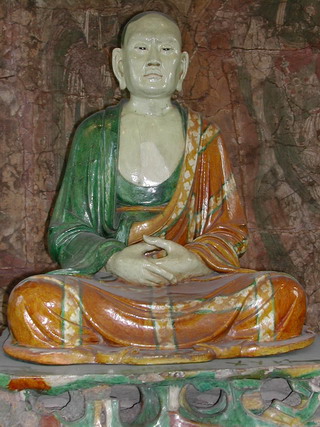| Contribution of article to Qufu Shaolin Martial Arts School website |
| Written by Richard Jeffery | |||
| Saturday, 09 January 2010 | |||
Details of the article, in part derived from original documents concerning Grandmaster Chee Kim Thong's description of the special spiritual character of one particular rare, traditional Shaolin Boxing System -- Luohan Ru Yi Quan -- and guidance concerning the proper approach to study of traditional gong fu, are provided below.
The Spirit of Gong Fuby Master Alan Tinnion
Training guidance and the special spiritual character of Shaolin Boxing:
The knowledge that my Master imparted to me, and the experience of teaching this to people of Western culture and others (including the Far East) has with the passage of time made me aware for many years that the real essence and dynamics of Shaolin gong fu tend towards purely spiritual goals: through the very real hard work, related suffering / endurance, and dedication that pursuit of the Arts entail these goals are attained -- they are not attained easily, and certainly not by 'short-cuts'.One has to 'taste bitter [suffer] before one can taste sweet' [attain results that are real rather than superficial].
Shaolin gong fu is therefore not a matter of mere peerless practical fighting technique. It is, rather, a uniquely effective means, perfected over many, many, centuries by the Shaolin Temple Warrior Monks for attainment of spiritual objectives; foremost of which is the Buddhist value of self-mastery [perseverance / tolerance, and freedom from worldly emotions and perspectives].
To attain real 'gong fu' is not at all an easy matter, for it entails a genuinely humble, receptive attitude, and years of dedication and perseverance in training. This said, attainment of genuine Shaolin Boxing gong fu will be understood by its practitioners to be important not so much as a fighting technique / art, but rather -- and much more importantly -- as a means to realisation of the spiritual goals of self-possession, self-mastery, and a profound awareness of the rhythms of Nature and the importance of cultivation of the Buddhist values of kindness / compassion.
The splendour of Shaolin gong fu comes only in part from the brilliancy of its styles and techniques: for those who are prepared to properly study, persevere, and train in the Shaolin martial arts the rewards are much, much, more rewarding and are of a spiritual kind. Over the years I have taught and continue to teach many students. This has been and remains a most instructive and positive experience for me. And so, I would like to share, at this point the thoughts and wisdom of my Master -- provided in teaching guidance notes [from the original hand-written documents] -- concerning two topics: firstly, that of the motivations and attitudes to training of students, and secondly the philosophy and nature of one of the most rare arts (Luohan Ru Yi Quan) of the great heritage of traditional Shaolin gong fu".
Concerning the right attitude towards training:
Teaching Problems of Chinese Wushu, by Grandmaster Chee Kim Thong:
Now allow me to list my students attitude towards studying and their experience. Students have the following attitudes: They hope the more they study the better: There are too many styles of Wushu, needless to say the different schools are many and varied. The Forms in our school are very many. With all the time in the world they are hard to perfect, but students want their teacher to teach them something new everyday. To learn a new thing every day is bad for the student. If one day he is faced by an attacker, because his techniques are all over the place then he will be badly hurt. Students must learn each set well, without the desire for gain and with patience. The student should study well the foundation and the skill, and only then will he be able to use it. They hope to reach the secrets through study: The greatest secret of martial arts is perseverance ... only with regular practise, regular study and regular research can results be made. The majority of teachers hope that their disciples will quickly progress and achieve good success. They unceasingly correct and instruct, but do the students have the perseverance? If they do not then the greatest secret will be of no use. Actually the secret is only practise makes perfect and nothing more. It is only through the experience of studying. If a student can unceasingly practice and research, then he can discover many secrets. One of the most important secrets is to correctly practise the Sets. Loafing on the job and resorting to trickery: There are a few intelligent students of above average ability who very quickly learn the basics and always ask the teacher in the hope he will tell them how to use the techniques, and think they have it all once they get a superficial interpretation. I know it, I know how to use it, and that's enough. But what they have is just the surface. Then one day he crosses arms with another student and realizes his level is too low, and blames the teacher for not teaching him the secrets. Not having a speciality: Today study Shaolin, tomorrow Taiji, the next day study Bagua. This type of student obtains an undeserved reputation. People say that teacher is good and he says he has studied with him. They say another teacher's gong fu is terrific and he says he is his shifu. Everyday he has a new shifu and new gong fu. In the end this kind of person will achieve nothing. Not able to 'eat bitter': Real gong fu is hard work; stance, training gong, training the qi, sparring all includes suffering. It is hard work and difficult to study, but if when you practise you loaf about, quit practising and deliberately shirk, eventually you will have nothing -- so how can you have real gong fu. So students, the most important thing is to be sincere, diligent, able to endure suffering and seek excellence. Step by step make progress, gong fu is Not talking about it, it is practised through physical effort and suffering. The reason the gong fu of people of ages past was so profound was because they studied with such effort. The people of today study for a few years and consider it enough. This is a real pity."
Concerning the Spiritual character of the higher level of Shaolin gong fu:
“Luohan Ru Yi Quan Xin Fa" by Grandmaster Chee Kim Thong:
Shaolin Boxing has been passed down from the monks of the Shaolin Temple. But those that put the Way of the Mind first are few. Because this boxing art is very difficult to understand and hard to train, students often feel at a loss and unable to make progress and give up half way. The highest state of Buddhist Xin Fa is the communication of good feelings -- now does the art of boxing have these type of demands? Yes! But few are those who can teach and those who have an opportunity to really learn are even fewer, because those who learn this boxing skill need great intelligence and have to fully understand its nature before they can achieve it. When Master and student train this type of boxing no sound is uttered, training is done with arms in contact, with corresponding internal qi, and as the breathing becomes refined, the more you practise the more well built it becomes, and the more relaxed one becomes. By way of training 'qi' and 'yi' into 'gong' at the same time one should pay even more attention to the cultivation of kind feelings. All that the Shifu can explain and express are just a few guides to the Way. What is inside the student can only be known by him. So how to succeed? Just like when a person drinks water, only he knows how hot or cold it is. This set altogether has 108 different hand techniques not including repeated hand movements, to train once you need 45 minutes. You should practise 3 times a day, in three time divisions, mornings, afternoons, and evenings. This will be extremely good for your health. This will push your ability to use it, your Spirit and magnificent vigour to new heights. This Set includes the Dazun 9 Yang Gong, Wuji Gong, Tai Ji Gong, and Wuxing. Only the Dazun Jiu Yang Gong can make the internal qi pass step by step through the liver, spleen and lungs to inside the body and travel bit by bit to all the organs. No need to mention its use as a martial art, just this small section is enough to be effective in changing the tendons. Newcomers to this style may find, within 3 months, that they have small problems. If small sores appear on the hand, sores will appear by the side of the buttocks. Otherwise you might get upset stomach and emissions will be malodorous and black. This is the qi working inside, sweeping out what is unclean from the internal organs. Sometimes it will seem as if you have a fever, or a cold, but if you see the doctor and take his medicine there will be no effect, but your spirit will not necessarily be lacking in vitality. This is the result of the true qi surging through the body. This is what is different about internal gong boxing. Soft boxing is not necessarily internal gong boxing and hard boxing is not necessarily external gong boxing. Actually, the difference between internal and external gong boxing is whether, when someone is practicing a certain Form, that Form can make the internal qi flow inside and make the internal organs healthy. And afterwards be able to use the Mind to make the qi move, and cause the qi to become an air balloon to protect the body and transform the qi to jing that can be expressed by both hand and foot, and create outstanding internal jing. This style looks for stillness in the midst of movement, using the method of movement to train quiet gong. The hand methods are very complicated and hard to remember, the demands of the movements and intentions are very fine. Even more, the student must practise the hand techniques to an extremely natural and skillful level. Having reached a really deep understanding, you must ignore the hand and foot techniques. Pay then close attention to the aspects of breathing. Afterwards even the aspect of breathing one can forget, having oneself empty. There is nothing there and also nothing that is not there - boxing without Mind and Mind without boxing".
In the world of today for all who have a general or specialist interest in the Great heritage of Shaolin Boxing, it is most important to always recall the question. Why should I learn Shaolin gong fu, and if I study and train, what may I hope to attain? The words of my Master, detailed above, I feel provide the answers to these questions. The rewards of study and training with a sincere heart, and diligently, are indeed priceless and are available to All those who seek them and persevere will Not fail to find very Great rewards.
|
|||
| Last Updated ( Saturday, 09 January 2010 ) | |||


.jpg) "Over the course of decades, my Master, declared in his lifetime a 'Living National Treasure of the People's Republic of China', taught me many Forms, Styles, and Disciplines of traditional Shaolin gong fu. The knowledge of Shaolin Boxing that he imparted to me has been a profound and enduring influence upon my work as a dedicated teacher of traditional Chinese martial arts.
"Over the course of decades, my Master, declared in his lifetime a 'Living National Treasure of the People's Republic of China', taught me many Forms, Styles, and Disciplines of traditional Shaolin gong fu. The knowledge of Shaolin Boxing that he imparted to me has been a profound and enduring influence upon my work as a dedicated teacher of traditional Chinese martial arts. “I have been teaching martial arts for more than 40 years. I have taught many types of people -- wealthy and poor, intelligent and stupid, cunning and honest. The problems I have encountered are many, yet times of happiness have also been frequent.
“I have been teaching martial arts for more than 40 years. I have taught many types of people -- wealthy and poor, intelligent and stupid, cunning and honest. The problems I have encountered are many, yet times of happiness have also been frequent. “The Chan Sect of Buddhist belief started with Dazun, and there are many Buddhist disciples that emphasize the study of the Way of the Mind. But few are those who know of the relationship between the Shaolin School of Wushu and Buddhist Xin Fa.
“The Chan Sect of Buddhist belief started with Dazun, and there are many Buddhist disciples that emphasize the study of the Way of the Mind. But few are those who know of the relationship between the Shaolin School of Wushu and Buddhist Xin Fa.